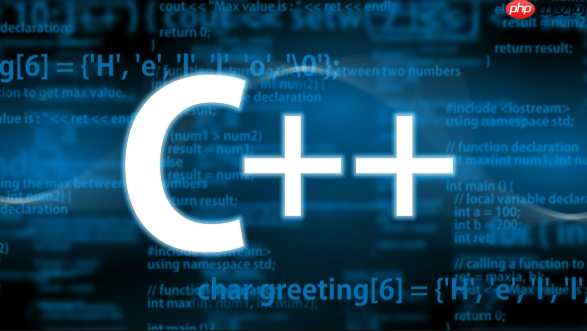基类析构函数必须为虚函数,以确保std::unique_ptr管理的派生类对象在销毁时正确调用派生类析构函数,避免资源泄露。使用std::make_unique创建对象并向上转型为基类指针可实现多态,配合override和final等关键字提升安全性。

std::unique_ptr
在C++的面向对象编程中,多态性(polymorphism)是核心特性之一。当我们通过基类指针来操作派生类对象时,比如将其存储在
std::unique_ptr<Base>
unique_ptr
解决这个问题的方法其实非常直接,甚至可以说是强制性的:将基类的析构函数声明为
virtual
std::unique_ptr
delete
unique_ptr
我们来看一个简单的例子:
立即学习“C++免费学习笔记(深入)”;
#include <iostream>
#include <memory> // For std::unique_ptr
// 基类
class Base {
public:
Base() { std::cout << "Base Constructor" << std::endl; }
// 关键点:声明为虚析构函数
virtual ~Base() { std::cout << "Base Destructor" << std::endl; }
virtual void greet() const { std::cout << "Hello from Base!" << std::endl; }
};
// 派生类
class Derived : public Base {
public:
Derived() { std::cout << "Derived Constructor" << std::endl; }
// 派生类析构函数,这里模拟释放派生类特有的资源
~Derived() override { std::cout << "Derived Destructor (releasing specific resources)" << std::endl; }
void greet() const override { std::cout << "Hello from Derived!" << std::endl; }
};
int main() {
// 使用 unique_ptr 管理派生类对象,但通过基类指针类型
std::unique_ptr<Base> ptr = std::make_unique<Derived>();
ptr->greet(); // 调用 Derived 的 greet()
// 当 ptr 超出作用域时,unique_ptr 会自动调用 delete ptr.get()
// 由于 Base 的析构函数是虚函数,会正确调用 Derived::~Derived()
// 然后再调用 Base::~Base()
std::cout << "ptr is about to go out of scope..." << std::endl;
return 0;
}运行这段代码,你会看到这样的输出:
Base Constructor Derived Constructor Hello from Derived! ptr is about to go out of scope... Derived Destructor (releasing specific resources) Base Destructor
这清晰地表明了虚析构函数和
unique_ptr
Base
virtual
Derived Destructor
这个问题,说到底,是C++多态机制的一个基本要求。当我们在面向对象设计中,希望通过基类接口来统一操作不同派生类的对象时,实际上我们是在利用基类指针(或引用)指向派生类对象的能力。这种能力本身带来了极大的灵活性,但同时也引入了一个隐患:对象的生命周期管理。
想象一下,你有一个
std::unique_ptr<Base>
Derived
unique_ptr
delete
Base
Base*
Base::~Base()
这就好比你买了一辆混合动力汽车,但维修师傅只知道怎么修普通汽油车。他把汽油部分修好了,却完全忽略了电动部分,甚至可能因为不了解而弄坏了电池组。对于我们的C++对象来说,
Derived
Base
Derived::~Derived()
所以,将基类的析构函数声明为
virtual
std::unique_ptr
使用
std::unique_ptr
创建派生类对象并用 unique_ptr
std::make_unique
// 假设 Base 有虚析构函数,Derived 继承自 Base std::unique_ptr<Derived> derived_ptr = std::make_unique<Derived>(); // 现在 derived_ptr 持有 Derived 对象的唯一所有权
向上转型(Upcasting)到基类 unique_ptr
unique_ptr
unique_ptr
unique_ptr
unique_ptr<Derived>
unique_ptr<Base>
std::unique_ptr<Base> base_ptr = std::make_unique<Derived>(); // base_ptr 现在持有一个 Derived 对象的唯一所有权,但它被视为 Base 类型
这里
base_ptr
Derived
Base
base_ptr
Derived
通过基类指针调用虚函数: 一旦你有了
std::unique_ptr<Base>
base_ptr->greet(); // 这会调用 Derived::greet(),因为 greet() 是虚函数
转移所有权:
std::unique_ptr
unique_ptr
std::move
std::unique_ptr<Base> another_ptr = std::move(base_ptr);
// 现在 another_ptr 拥有了对象的所有权,base_ptr 变为空
if (!base_ptr) {
std::cout << "base_ptr is now empty." << std::endl;
}
another_ptr->greet();在容器中使用 unique_ptr
std::vector
unique_ptr
#include <vector>
// ... (Base 和 Derived 类定义) ...
int main() {
std::vector<std::unique_ptr<Base>> objects;
objects.push_back(std::make_unique<Derived>());
objects.push_back(std::make_unique<AnotherDerivedClass>()); // 假设有另一个派生类
for (const auto& obj_ptr : objects) {
obj_ptr->greet(); // 同样会调用各自派生类的 greet()
}
// 当 objects 容器超出作用域时,所有 unique_ptr 都会自动销毁其管理的对象
// 并且会正确调用派生类的析构函数
return 0;
}通过这种方式,我们可以在一个容器中存储异构的对象集合,并且
unique_ptr
delete
unique_ptr
即便
unique_ptr
最大的陷阱:忘记虚析构函数。 这简直是老生常谈了,但依然是导致多态对象管理失败的首要原因。如果你的基类设计出来就是为了被继承,并且可能通过基类指针删除派生类对象,那么它的析构函数就必须是虚函数。即使当前基类析构函数是空的,也要声明为
virtual
避免原始指针与 unique_ptr
unique_ptr
unique_ptr
unique_ptr::get()
delete
std::move
unique_ptr
unique_ptr
unique_ptr
std::shared_ptr
最佳实践:始终使用 std::make_unique
unique_ptr
std::make_unique<T>()
new T()
std::make_unique
最佳实践:基类析构函数即使为空也应为 virtual
Base
virtual ~Base() {}最佳实践:善用 override
override
考虑 final
final
设计基类时,明确其是否为抽象基类。 如果基类包含纯虚函数,那么它就是抽象基类,不能直接实例化。这通常意味着它只提供接口,而具体实现由派生类完成。
unique_ptr
在我看来,
unique_ptr
以上就是C++unique_ptr与继承类对象管理方法的详细内容,更多请关注php中文网其它相关文章!

每个人都需要一台速度更快、更稳定的 PC。随着时间的推移,垃圾文件、旧注册表数据和不必要的后台进程会占用资源并降低性能。幸运的是,许多工具可以让 Windows 保持平稳运行。

Copyright 2014-2025 https://www.php.cn/ All Rights Reserved | php.cn | 湘ICP备2023035733号